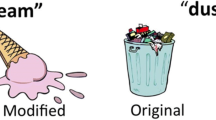Abstract
Comprehension of ambiguous three-term locative sentences such as “The book is on the desk in the crate” was examined in a verification experiment. Subjects consistently chose a representation in which the spatial ordering of the objects described was congruent with the surface order of terms in the sentence. This rule was overridden, however, by the presence of semantic constraints among the terms (e.g., “The shirt is in the house on the chair”). When the order of locative clauses within each sentence was reversed in the second half of the experiment, subjects tended to change their representation to conform with the new surface order if the initial coding had been based on surface order. This change occurred more frequently when the objects involved more abstract, geometric shapes. The importance of syntactic, semantic, and episodic information in the comprehension of sentences is discussed.
Similar content being viewed by others
References
Anderson, J. R. (1974). Verbatim and propositional representation of sentences in immediate and long-term memory.J. Verb. Learn. Verb. Behav.,13:149–162.
Bever, T. G. (1970). The cognitive basis for linguistic structures. In Hayes, J. R. (ed.),Cognition and the Development of Language, Wiley, New York.
Catlin, J., and Micham, D. L. (1975). Semantic representations as procedures for verification.J. Psycholing. Res.,4:209–225.
Chase, W. G., and Clark, H. H. (1972). Mental operations in the comparison of sentences and pictures. In Gregg, L. W. (ed.),Cognition in Learning and Memory, Wiley, New York.
Clark, H. H. (1969). Linguistic processes in deductive reasoning.Psychol. Rev. 76:387–404.
Clark, H. H. (1973). The language-as-fixed-effect fallacy: A critique of language statistics in psychological research.J. Verb. Learn. Verb. Behav. 12:335–359.
Fodor, J. A., Bever, T. G., and Garrett, M. F. (1974).The Psychology of Language, McGraw-Hill, New York.
Glucksberg, S., Trabasso, T., and Wald, J. (1973). Linguistic structures and mental operations.Cogn. Psychol. 5:338–370.
Green, D. W. (1975). The effects of task on the representation of sentences.J. Verb. Learn. Verb. Behav. 14:275–283.
Kintsch, W. (1974).The Representation of Meaning in Memory, Lawrence Erlbaum Associates, New York.
Mistler-Lachman, J. (1975). Queer sentences, ambiguity, and levels of processing.Memory Cognition 3:395–400.
Olson, D. R., and Filby, N. (1972). On the comprehension of active and passive sentences.Cogn. Psychol. 3:361–381.
Perfetti, C. A. (1972). Psychosemantics: Some cognitive aspects of structural meaning.Psychol. Bull. 78:241–259.
Posner, M. I. (1969). Abstraction and the process of recognition. In Spence, J. T., and Bower, G. H., (eds.),The Psychology of Learning and Motivation, Vol. 3, Academic Press, New York.
Sachs, J. S. (1967). Recognition memory for syntactic and semantic aspects of related discourse.Percept. Psychophys. 2:437–442.
Slobin, D. (1966). Grammatical transformations and sentence comprehension in childhood and adulthood.J. Verb. Learn. Verb. Behav. 5:219–227.
Sulin, R. A., and Dooling, D. J. (1974). Intrusion of a thematic idea in retention of prose.J. Exp. Psychol.,103:255–262.
Tulving, E. (1972). Episodic and semantic memory. In Tulving, E., and Donaldson, W. (eds.),Organization of Memory, Academic Press, New York.
Walker, J. H. (1975). Real-world variability, reasonableness and memory representations for concepts.J. Verb. Learn. Verb. Behav. 14:241–252.
Author information
Authors and Affiliations
Additional information
This research was conducted by the second author under the directorship of the first author.
Rights and permissions
About this article
Cite this article
Fischler, I., Goodman, R. Semantic and episodic constraints on the use of surface-order cues in the comprehension of locative sentences. J Psycholinguist Res 7, 121–134 (1978). https://doi.org/10.1007/BF01074288
Received:
Issue Date:
DOI: https://doi.org/10.1007/BF01074288




